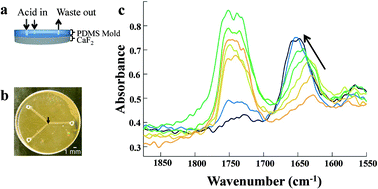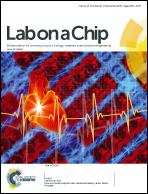Fabrication of IR-transparent microfluidic devices by anisotropic etching of channels in CaF2†
Abstract
A simple fabrication method for generating infrared (IR) transparent microfluidic devices using etched CaF2 is demonstrated. To etch microfluidic channels, a poly(dimethylsiloxane) (PDMS) microfluidic device was reversibly sealed on a CaF2 plate and acid was pumped through the channel network to perform anisotropic etching of the underlying CaF2 surface. To complete the CaF2 microfluidic device, another CaF2 plate was sealed over the etched channel using a 700 nm thick layer of PDMS adhesive. The impact of different acids and their concentrations on etching was studied, with HNO3 giving the best results in terms of channel roughness and etch rates. Etch rate was determined at etching times ranging from 4–48 hours and showed a linear correlation with etching time. The IR transparency of the CaF2 device was established using a Fourier Transform IR microscope and showed that the device could be used in the mid-IR region. Finally, utility of the device was demonstrated by following the reaction of N-methylacetamide and D2O, which results in an amide peak shift to 1625 cm−1 from 1650 cm−1, using an FTIR microscope.


 Please wait while we load your content...
Please wait while we load your content...